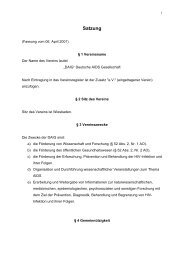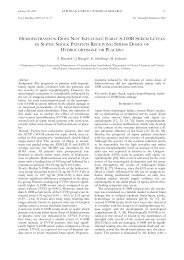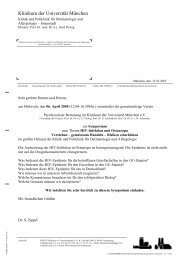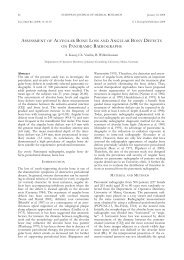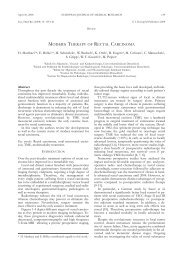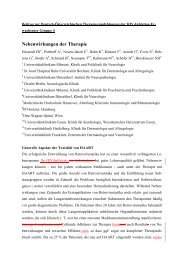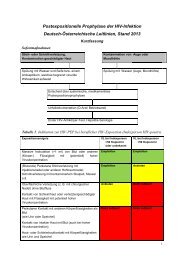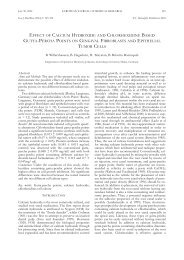fecal elastase 1 and vitamin d3 in patients with osteoporotic bone ...
fecal elastase 1 and vitamin d3 in patients with osteoporotic bone ...
fecal elastase 1 and vitamin d3 in patients with osteoporotic bone ...
Create successful ePaper yourself
Turn your PDF publications into a flip-book with our unique Google optimized e-Paper software.
February 25, 2008 EUROPEAN JOURNAL OF MEDICAL RESEARCH<br />
71<br />
Table 2. Correlation between <strong>fecal</strong> <strong>elastase</strong> 1 <strong>and</strong> 25(OH)D 3, 1,25(OH) 2D 3, Calcium, PTH <strong>and</strong> BMI. p < 0.05 <strong>in</strong>dicates a significant<br />
correlation.<br />
Parameter 25(OH)D 3 1,25(OH) 2D 3 Calcium PTH BMI<br />
Fecal <strong>elastase</strong> 1<br />
Correlation Pearson 0.620 0.300 0.256 0.423 -0.114<br />
p p < 0.01 p < 0.01 p < 0.01 p < 0.01 p= 0.141<br />
N 126 97 167 140 167<br />
Fecal <strong>elastase</strong> 1<br />
Correlation Spearman 0.697 0.361 0.236 0.490 -0.137<br />
p p < 0.01 p < 0.01 p < 0.01 p < 0.01 p=0.079<br />
N 126 97 167 140 167<br />
duced <strong>fecal</strong> <strong>elastase</strong> 1 is connected <strong>with</strong> lowered <strong>vitam<strong>in</strong></strong><br />
D 3 <strong>and</strong> this could be demonstrated by comparison<br />
between patient groups <strong>with</strong> different severance<br />
grades of <strong>fecal</strong> <strong>elastase</strong> 1 deficiency as well as by direct<br />
correlation. In our further studies we could demonstrate<br />
a similar connection between <strong>fecal</strong> <strong>elastase</strong> 1, <strong>vitam<strong>in</strong></strong><br />
D 3 <strong>and</strong> BMD [14, 15], but no one of the <strong>patients</strong><br />
had <strong>osteoporotic</strong> <strong>bone</strong> fractures <strong>and</strong> all had<br />
chronic pancreatitis. Nevertheless our present results<br />
are consistant <strong>with</strong> the observations we made at our<br />
<strong>patients</strong> <strong>with</strong> exocr<strong>in</strong>e <strong>in</strong>sufficiency caused by chronic<br />
pancreatitis. The fact of reduced BMD <strong>in</strong> our pancreatic<br />
<strong>patients</strong> <strong>with</strong> this way reduced <strong>vitam<strong>in</strong></strong> D 3 serum<br />
levels allows the conclusion, that osteoporosis <strong>in</strong> our<br />
<strong>patients</strong> <strong>with</strong> <strong>osteoporotic</strong> <strong>bone</strong> fractures could be additional<br />
caused by <strong>vitam<strong>in</strong></strong> D deficiency <strong>in</strong> consequence<br />
of occult exocr<strong>in</strong>e pancreatic <strong>in</strong>sufficiency.<br />
Poskitt et al. [13] reported, that a depletion of <strong>vitam<strong>in</strong></strong><br />
D storage is ma<strong>in</strong>ly caused by a reduced exposition to<br />
the sun, but altogether serum levels of lipid soluble <strong>vitam<strong>in</strong></strong><br />
D 3 depends on photosynthesis <strong>in</strong> the sk<strong>in</strong> as<br />
well as on direct <strong>in</strong>test<strong>in</strong>al resorption. S<strong>in</strong>ce only 40%<br />
of experimentally adm<strong>in</strong>istrered, radio-actively labeled<br />
<strong>vitam<strong>in</strong></strong> D 3 is absorbed by the <strong>in</strong>test<strong>in</strong>es of <strong>patients</strong><br />
<strong>with</strong> pancreatic <strong>in</strong>sufficiency [19], contrary to 80-90%<br />
<strong>in</strong> healthy persons, exocr<strong>in</strong>e pancreatic function ga<strong>in</strong>s<br />
<strong>in</strong> significance <strong>and</strong> supports our own results <strong>with</strong> correspond<strong>in</strong>g<br />
evaluation of <strong>fecal</strong> <strong>elastase</strong> 1. It is conceivable<br />
that <strong>fecal</strong> <strong>elastase</strong> 1 plays an <strong>in</strong>dependent role<br />
<strong>with</strong> regard to <strong>vitam<strong>in</strong></strong> D 3 supply <strong>in</strong> the organism.<br />
Upon pass<strong>in</strong>g through the <strong>in</strong>test<strong>in</strong>es, <strong>elastase</strong> 1 complexes<br />
<strong>with</strong> neutral steroids [20]. S<strong>in</strong>ce <strong>vitam<strong>in</strong></strong> D 3 is<br />
also a sterol molecule, there is a hypothetical mechanism<br />
by which reduced <strong>vitam<strong>in</strong></strong> D 3 absorption at reduced<br />
<strong>fecal</strong> <strong>elastase</strong> 1 could be l<strong>in</strong>ked. In the present<br />
study it is evident, that <strong>vitam<strong>in</strong></strong> D 3 serum levels are<br />
more than 53% respectively more than 60% reduced<br />
<strong>in</strong> <strong>patients</strong> <strong>in</strong> comparison to controls. Therefore, as<br />
described by Scharla et al. <strong>and</strong> Chapuy et al. [8, 9],<br />
even low normal serum concentrations of <strong>vitam<strong>in</strong></strong> D<br />
can lead to osteopenia due to <strong>in</strong>creased <strong>bone</strong> loss. The<br />
prevalence of exocr<strong>in</strong>e pancreatic <strong>in</strong>sufficiency or lowered<br />
<strong>fecal</strong> <strong>elastase</strong> 1 <strong>in</strong> <strong>patients</strong> <strong>with</strong> <strong>osteoporotic</strong> <strong>bone</strong><br />
fractures is jet unknown, because, to our knowledge,<br />
no data were published until now. But results of the<br />
present study make it highly probable that previous<br />
unknown exocr<strong>in</strong>e pancreatic <strong>in</strong>sufficiency, especially<br />
lowered <strong>fecal</strong> <strong>elastase</strong> 1, <strong>in</strong> <strong>patients</strong> <strong>with</strong> <strong>osteoporotic</strong><br />
<strong>bone</strong> fracture is much more prevalent than suggested<br />
so far.<br />
Even when other authors describe that BMI is, of<br />
all anthropometric factors, the strongest predictor of<br />
BMD [21, 22], our data do not support the relevance<br />
of BMI because no one of the <strong>patients</strong> had a low BMI<br />
but all had <strong>osteoporotic</strong> <strong>bone</strong> fracture.<br />
REFERENCES<br />
1. Kanis JA. Diagnosis of osteoporosis <strong>and</strong> assessment of<br />
fracture risk. Lancet. 2002;359(9321):1929-36.<br />
2. Center JR, Nguyen TV, Schneider D, Sambrook PN, Eisman<br />
JA. Mortality after all major types of <strong>osteoporotic</strong><br />
fracture <strong>in</strong> men <strong>and</strong> women: an observational study.<br />
Lancet. 1999;353(9156):878-82.<br />
3. Hasserius R, Karlsson MK, Nilsson BE, Redlund-Johnell<br />
I, Johnell O. Prevalent vertebral deformities predict <strong>in</strong>creased<br />
mortality <strong>and</strong> <strong>in</strong>creased fracture rate <strong>in</strong> both men<br />
<strong>and</strong> women: a 10-year population-based study of 598 <strong>in</strong>dividuals<br />
from the Swedish cohort <strong>in</strong> the European Vertebral<br />
Osteoporosis Study. Osteoporos Int. 2003;14(1):<br />
61-8.<br />
4. R<strong>and</strong>ell AG, Nguyen TV, Bhalerao N, Silverman SL,<br />
Sambrook PN, Eisman JA. Deterioration <strong>in</strong> quality of life<br />
follow<strong>in</strong>g hip fracture: a prospective study. Osteoporos<br />
Int. 2000;11(5):460-6.<br />
5. Scaf-Klomp W, van Sonderen E, S<strong>and</strong>erman R, Ormel J,<br />
Kempen GI. Recovery of physical function after limb <strong>in</strong>juries<br />
<strong>in</strong> <strong>in</strong>dependent older people liv<strong>in</strong>g at home. Age<br />
Age<strong>in</strong>g. 2001;30(3):213-9.<br />
6. Nguyen T, Sambrook P, Kelly P, et al. Prediction of <strong>osteoporotic</strong><br />
fractures by postural <strong>in</strong>stability <strong>and</strong> <strong>bone</strong> density.<br />
Bmj. 1993;307(6912):1111-5.<br />
7. Schmidt-Gayk H, Thomas L, Stracke H. M<strong>in</strong>eralhaushalt<br />
und Nebenschilddrüse. In: Thomas L, ed. Labor und Diagnose.<br />
4 ed. Marburg: Die Mediz<strong>in</strong>ische Verlagsgesell -<br />
schaft; 1992:342-79.<br />
8. Scharla SH, Scheidt-Nave C, Leidig G, et al. Lower serum<br />
25-hydroxy<strong>vitam<strong>in</strong></strong> D is associated <strong>with</strong> <strong>in</strong>creased <strong>bone</strong><br />
resorption markers <strong>and</strong> lower <strong>bone</strong> density at the proximal<br />
femur <strong>in</strong> normal females: a population-based study.<br />
Exp Cl<strong>in</strong> Endocr<strong>in</strong>ol Diabetes. 1996;104(3):289-92.<br />
9. Chapuy MC, Chapuy P, Thomas JL, Hazard MC, Meunier<br />
PJ. Biochemical effects of calcium <strong>and</strong> <strong>vitam<strong>in</strong></strong> D supplementation<br />
<strong>in</strong> elderly, <strong>in</strong>stitutionalized, <strong>vitam<strong>in</strong></strong> D-deficient<br />
<strong>patients</strong>. Rev Rhum Engl Ed. 1996;63(2):135-40.<br />
10. Chapuy MC, Arlot ME, Duboeuf F, et al. Vitam<strong>in</strong> D 3 <strong>and</strong><br />
calcium to prevent hip fractures <strong>in</strong> the elderly women. N<br />
Engl J Med. 1992;327(23):1637-42.<br />
11. Dawson-Hughes B, Harris SS, Krall EA, Dallal GE. Effect<br />
of calcium <strong>and</strong> <strong>vitam<strong>in</strong></strong> D supplementation on <strong>bone</strong>






